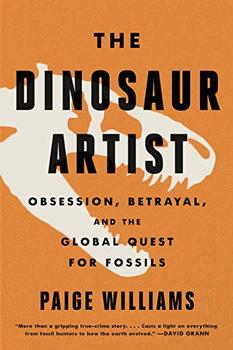Summary | Excerpt | Reviews | Beyond the Book | Readalikes | Genres & Themes | Author Bio

Obsession, Betrayal, and the Quest for Earth's Ultimate Trophy
by Paige Williams
Another name to remember is Kathy Wankel. When the Smithsonian National Museum of Natural History (NMNH) unveils its new hall of dinosaurs in 2019, after a five-year, $48 million renovation, it will feature, for the first time, its own Tyrannosaurus rex, courtesy of Wankel, a Montana rancher who in 1988 found the skeleton now known as "The Nation's T. rex." The specimen is considered important partly because it includes the first complete T. rex forelimb known to science.
Despite amateurs' contributions, science and commerce developed stark opposing arguments:
Commerce: overregulation destroys the public's interest in the natural world.
Science: commodification compromises our evolving understanding of the planet.
Commerce: science doesn't need hundreds or even dozens of specimens of one species.
Science: multiple specimens elucidate an organism and its environment over time.
Commerce: private collectors wind up donating their stuff to museums anyway.
Science: specimens collected under nonscientific conditions are worthless to research.
Commerce: most museum fossils land in storage, never to be studied.
Science: stored fossils have generated profound advances decades after their discovery.
Commerce: scientists are stingy and elitist, with their snooty PhDs.
Science: commercial hunters are destructive and greedy.
Such were the contours of a seemingly intractable conflict. "Whether or not it's okay to sell and buy fossils is a matter of debate on scientific and ethical grounds, with analytical rigor and professional honesty squaring off against free enterprise," the paleontologists Kenshu Shimada and Philip Currie and their colleagues wrote in Palaeontologia Electronica. They called "the battle against heightened commercialization" of fossils "the greatest challenge to paleontology of the 21st century."
On both sides, the disagreement struck people as a shame, because scientists and commercial hunters at least were united in their love of one thing: fossils. If only more people would take a sincere interest in "rocks that can talk to you," the paleobotanist Kirk Johnson, head of the Smithsonian's NMNH, once told me. "The fact that our planet buries its dead is an amazing thing. The fact that you can read the history of the planet in fossils is profoundly cool. A smart kid can find a fossil and tell you what happened to the planet 4 billion years ago. We finally figured out how the planet works, and we did it through fossils."
If the confessed dinosaur thief Nate Murphy became an emblem of the tension between science and commerce, he didn't reign for long. In the spring of 2012, a case emerged that surpassed all others in its international scope and labyrinthine particulars, touching on collectors, smuggling, marriage, democracy, poverty, artistry, museums, mining, Hollywood, Russia, China, criminal justice, presidential politics, explorers, Mongolian culture, the auction industry, and the history of science. This book is that untold story.
CHAPTER 1
"SUPERB TYRANNOSAURUS SKELETON"
ON THE LAST DAY OF HIS OLD LIFE, THE DINOSAUR HUNTER went to the beach. This was Florida—Atlantic side, not Gulf. An overcast Sunday morning: the twentieth day of the fifth month of the two thousand and twelfth year CE. Eric Prokopi was thirty-eight. His daughter, Rivers, was turning three. Eric and his wife, Amanda, lugged a carload of party gear from their home in Gainesville across the upper peninsula, to St. Augustine, a sixteenth-century city named for a fourth-century theologian who, as a boy, stole pears off a tree simply because it was forbidden, later writing, "Foul was the evil and I loved it."
The Prokopis drove straight onto the foreshore, as is done in that town, and set up on the sand. The previous year's party theme had been Pirates & Princesses. Eric, a tall, muscular ex-swimmer, had dressed in a frilly pink frock and tiara, accessorized with the black wraparound sunglasses of a mercenary. This year's theme was Little Mermaid. Invitations pictured the birthday girl, a brown-eyed towhead with a heart-shaped face, wearing a finned tail and a platinum wig whose synthetic waves cascaded down her back. Now she had on a shimmering green skirt and a purple plastic crown, to which Amanda had affixed a dried starfish from the burgeoning inventory of her new interior decorating business, Everything Earth. Rivers's brother, Greyson, two years older, wore a long-sleeved black swim shirt printed with the outline of a great white shark, and wraparound shades like his dad's. All the essential elements were soon in place: tent, tables, sunscreen, cupcakes. A clear-acrylic cooler dispensed cerulean Hawaiian Punch. A watermelon, cut in the shape of an open-mouthed shark, offered a gullet full of gummy fish that glowed like sunlit rubies.
Excerpted from The Dinosaur Artist by Paige Williams. Copyright © 2018 by Paige Williams. Excerpted by permission of Hachette Books. All rights reserved. No part of this excerpt may be reproduced or reprinted without permission in writing from the publisher.
Your guide toexceptional books
BookBrowse seeks out and recommends the best in contemporary fiction and nonfiction—books that not only engage and entertain but also deepen our understanding of ourselves and the world around us.